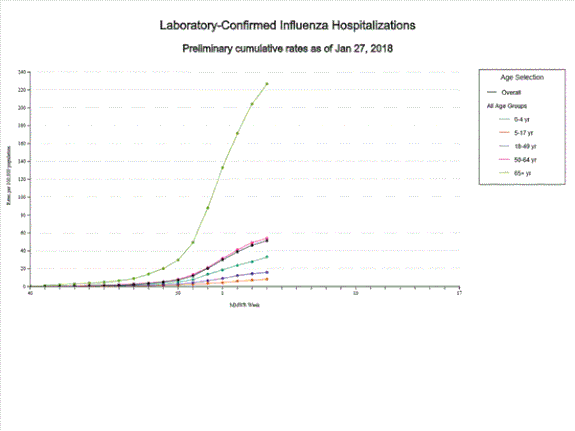Flu season has gone from bad to worse, CDC reports, as 17 more children die in the US

Top doctors at the Centers for Disease and Control and Prevention (CDC) continue to report more grim news about this year's severe flu season, largely due to a particularly nasty strain of the virus.
On Friday morning, the CDC provided updated influenza statistics, gathered from the week spanning Jan. 21 to Jan. 28. Although there's a deluge of numbers and statistics to consider, the CDC underscored two significant trends:
Flu activity: Already widespread around the nation, it's still increasing.
Hospitalization rates are the highest they've ever been for this point in the flu season since current data collection methods began in 2010.
"This season is turning out to be a particularly challenging one," said Dan Jernigan, director of the influenza division at the National Center for Immunization and Respiratory Diseases.
"This is an unusual flu pattern in the U.S."
SEE ALSO: This year’s flu shot might not stop the virus, but it can fend off the worst symptoms
The high rates of hospitalization are what's particularly unusual, explained Anne Schuchat, the acting CDC director. The Trump-appointed CDC director, Brenda Fitzgerald, stepped down on Jan. 31 after news reports revealed she bought tobacco stocks soon after taking over the health agency, which is in charge of smoking prevention efforts.
As of Jan. 27, about 51 out of 100,000 Americans were hospitalized for influenza. This, noted Schuchat, is higher than rates during the previous record-holding season, which occurred during 2014-2015 season.
"It's pretty bad news to see that hospitalization," said Schuchat, who noted reports from around the country of overcrowded hospitals.
Schuchat said that recent leadership changes at the CDC amid this remarkably severe flu season will not impede the agency's mission to protect Americans.

Image: cdc
The CDC also said 17 more children died of the flu during the fourth week of January, for a seasonal total of 53 pediatric deaths. Only 20 percent of these children had been vaccinated. During the 2014-2015 season, 148 children were killed by the flu.
It's still too early to know if this season will maintain its current trends and surpass the 2014-2015 season in flu-related fatalities.
"The flu is complex and difficult to predict," said Schuchat.
And this year's dominant virus, H3N2 (also called the "Hong Kong" flu), tends to mutate during the flu season more than other strains, rendering our vaccines less effective.
#Flu is widespread across the U.S. While a flu shot is still the best way to prevent flu, antiviral drugs are the best way to treat flu infection. Watch to learn how you can help protect yourself and your family. https://t.co/UFbzQBUd4d pic.twitter.com/vp9d9csxLl
— CDC (@CDCgov) February 1, 2018
There may, however, "be a little good news," Schuchat said, citing that "activity in the West may be easing up."
Of the Lower 48 states, Oregon is the only one reporting "regional" flu activity for the week ending Jan. 27. For every other state in the contiguous U.S., flu activity remains "widespread."
WATCH: Your next flu shot may be replaced with this patch


